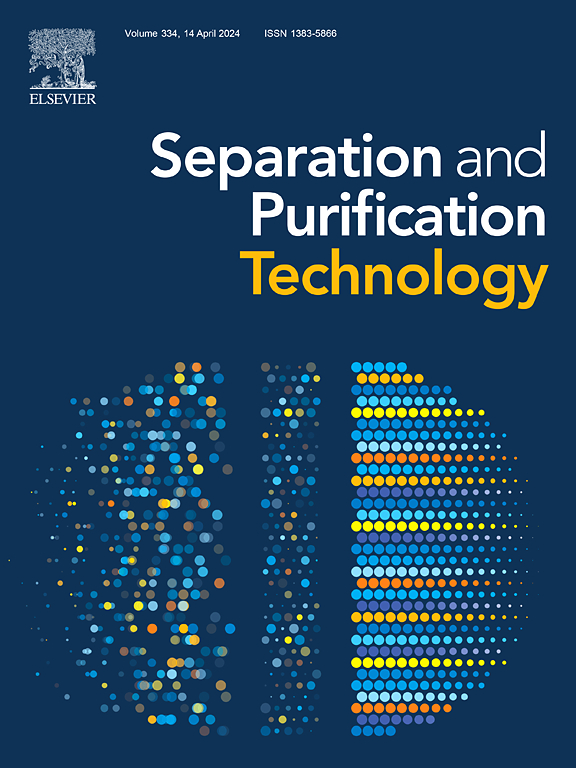硼酸热解调节铁单原子催化剂中二级壳硼配位对过氧乙酸高效活化和双酚A降解的影响
IF 9
1区 工程技术
Q1 ENGINEERING, CHEMICAL
引用次数: 0
摘要
在本研究中,我们将硼酸加入到单原子催化剂(SACs)的合成中,在单原子催化剂中,硼酸具有促进铁分散和引入硼配位的双重作用。我们的研究结果表明,由熔融硼酸形成的氧化硼既是一种高效的高温碳化剂,也是一种金属阻塞介质,有效抑制了铁SAC材料中铁纳米颗粒的形成(Fe@NBC)。该材料的主要特征是氮配位的单铁原子,硼原子成功地结合到二级配位壳层中。Fe@NBC表现出优异的fenton类催化活性,通过过氧乙酸(PAA)活化,在30 min内完全去除10 mg/L双酚A (BPA)。硼含量由2.78 %提高到4.23 %,BPA去除率由52.1% %提高到100% %。密度泛函理论(DFT)计算表明,缺电子的硼原子调节了Fe-N4活性位点的电子结构。随着第二壳层的硼配位数从1增加到2,中心铁原子失去更多的电子(1.20e-到2.25e-)。这加强了氧化剂在Fe位点的吸附(- 0.96 eV至- 1.07 eV),促进了PAA和Fe活性中心之间的电子转移,同时降低了羟基自由基形成的能量屏障。这项工作为设计硼介导的fenton类催化剂有效降解水中有机污染物提供了重要的见解。本文章由计算机程序翻译,如有差异,请以英文原文为准。


Boric acid pyrolysis modulating secondary-shell boron coordination in iron single-atom catalysts for high-efficiency peracetic acid activation and bisphenol A degradation
In this study, we incorporated boric acid into the synthesis of single-atom catalysts (SACs), where it served dual roles by facilitating iron dispersion and introducing boron coordination. Our results show that boron oxide formed from molten boric acid acts as both an efficient high-temperature carbonization agent and a metal-blocking medium, effectively suppressing iron nanoparticle formation in the resulting iron SAC material (Fe@NBC). The material features predominantly nitrogen-coordinated single iron atoms, with boron atoms successfully incorporated into secondary coordination shells. Fe@NBC demonstrates excellent Fenton-like catalytic activity, completely removing 10 mg/L bisphenol A (BPA) within 30 min through peracetic acid (PAA) activation. Increasing the boron content from 2.78 % to 4.23 % improved BPA removal efficiency from 52.1 % to 100 %. Density functional theory (DFT) calculations reveal that electron-deficient boron atoms adjust the electronic structure of Fe-N4 active sites. As the boron coordination number in the second shell increases from 1 to 2, the central iron atom loses more electrons (1.20e- to 2.25e-). This strengthens the oxidant’s adsorption at the Fe site (−0.96 eV to −1.07 eV), boosts electron transfer between PAA and the Fe active center while reducing the energy barrier for hydroxyl radical formation. This work provides critical insights for designing boron-mediated Fenton-like catalysts to efficiently degrade organic pollutants in water.
求助全文
通过发布文献求助,成功后即可免费获取论文全文。
去求助
来源期刊

Separation and Purification Technology
工程技术-工程:化工
CiteScore
14.00
自引率
12.80%
发文量
2347
审稿时长
43 days
期刊介绍:
Separation and Purification Technology is a premier journal committed to sharing innovative methods for separation and purification in chemical and environmental engineering, encompassing both homogeneous solutions and heterogeneous mixtures. Our scope includes the separation and/or purification of liquids, vapors, and gases, as well as carbon capture and separation techniques. However, it's important to note that methods solely intended for analytical purposes are not within the scope of the journal. Additionally, disciplines such as soil science, polymer science, and metallurgy fall outside the purview of Separation and Purification Technology. Join us in advancing the field of separation and purification methods for sustainable solutions in chemical and environmental engineering.
 求助内容:
求助内容: 应助结果提醒方式:
应助结果提醒方式:


